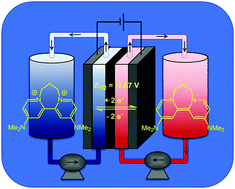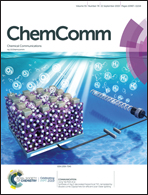An organic super-electron-donor as a high energy density negative electrolyte for nonaqueous flow batteries†
Abstract
A highly reducing diquat-type molecule was explored as a negative electrolyte for nonaqueous redox flow batteries. The molecule displays a highly negative 2+/0 reduction potential of −1.67 V (vs. ferrocene), a low mass per electron transferred, and good solubility in CH3CN in both redox states. Moderate capacity retention is observed during electrochemical charge–discharge cycling. A pathway for decomposition during electrochemical cycling is elucidated, and this provides a clear path forward for enhancing stability.

- This article is part of the themed collection: Celebrating our 2020 Prize and Award winners


 Please wait while we load your content...
Please wait while we load your content...